|
When possible it is best to measure several radii from a tree.
First measure your radii with CooRecorder so you have, say three coordinate files (.pos files) In CDendro, create a new empty collection with Collections/Create new collection. This will automatically be the target collection. Use the command "Samples/Open coordinate file" to open your coordinate files from that same tree - you can do that in one operation if you select all the files in the "Open-window". (To select several files: Hold down the control-key and click successively on several file names.) Run correlation tests for these files to find out how they match and add them successively to your collection. Save the collection as a collection file (.fil extension) as documentation.
See that "No DeTrending" is selected and click the button "Create mean value sample" In the new sample window, use the menu command "Samples/Save ring width data as" to get a .wid file with the averaged ring width values - i.e. with mean values of the ring widths. There are also menu commands to save ring widths in .rwl format or in .fh format. Though then you first have to set a dating year to your mean value sample. (Use the button Set date of youngest ring on the Workbench tab or set a year dating to your collection before you create the mean value sample.) Note: You may prefer to save the collection in a decadal file to save your original ring width data for documentation. In that case you first have to set a year-date to the collection. If you have not dated your sample yet, you can use a year-number from the future, e.g. year 4000. Note: Since CDendro version 7.5 (May 2012) there is a separate menu command to "collapse" a multi-radii collection of several trees into a collection where each tree is only represented by one member. Though this command "Collections/Save as New collection with members summed by stem" requires that you follow a file naming convention (described below) which will tell CDendro which series (which .pos file) belong to which tree. See the section "More on multi radii collections below". |
How to name radii taken from the same trunk
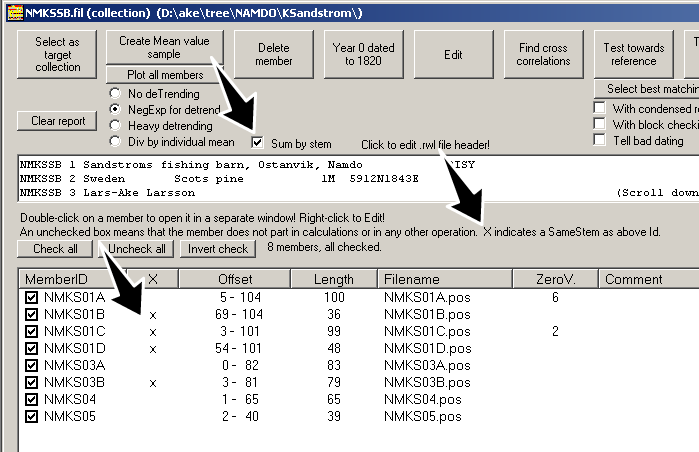
|
Note: You do not have to calculate mean value curves for each tree and then add these to a collection consisting of e.g. only mean values. You can as well add all your radii directly to a collection. To let CDendro know which radius comes from which tree, you should carefully select the identities of your samples.
Please note, when you calculate the mean value from this collection the checkbox "Sum by stem" should be checked!
|
How to plot several radii in parallel
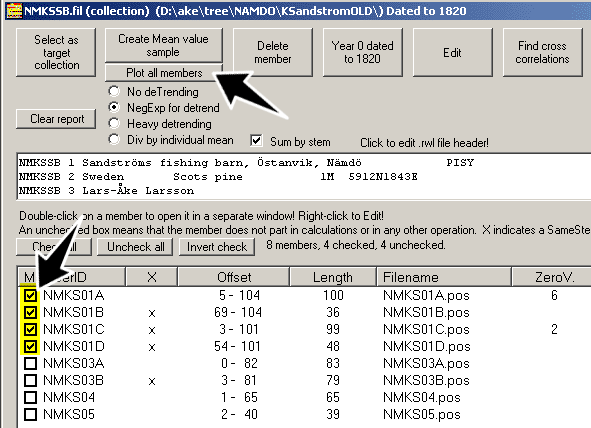
Use the "Uncheck all" button
Check the members of the stem of interest
Click the button "Plot all members"
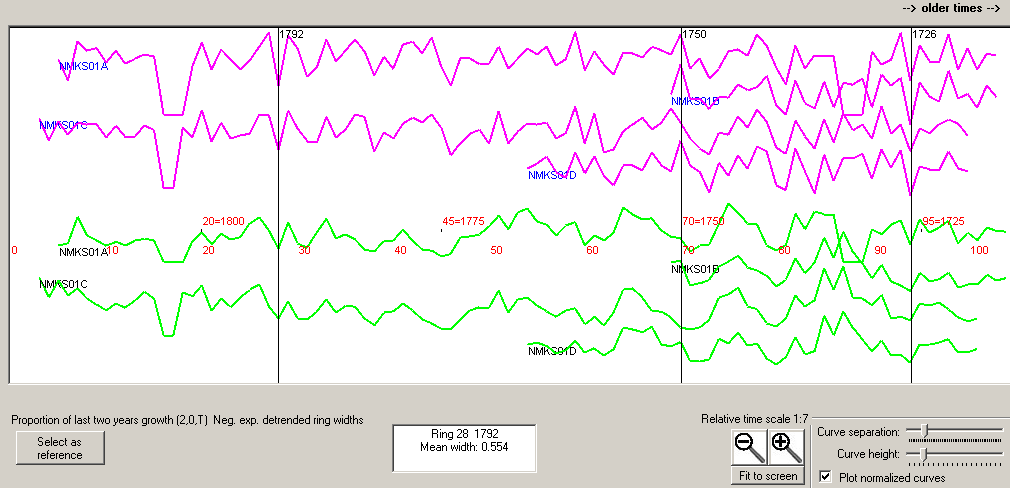
When you move the cursor over the curve diagram a vertical line follows your cursor symbol.
When you ctrl-click on the diagram a vertical line is left at that place as shown on the picture above.
If you ctrl-click again at a line, then it will be removed.
Actual year number - as dated - is shown at the top of the line.
Sum by stem and Test towards rest of collection

where some of them originate from the same trunk,
you should see that "Sum by stem" is really checked (it is so by default).
When "Sum by stem" is checked a certain radius is tested towards the rest of the collection excluding other radii from that same stem.

When other radii from the same trunk are added to the collection before comparison, then matching gives much higher values.
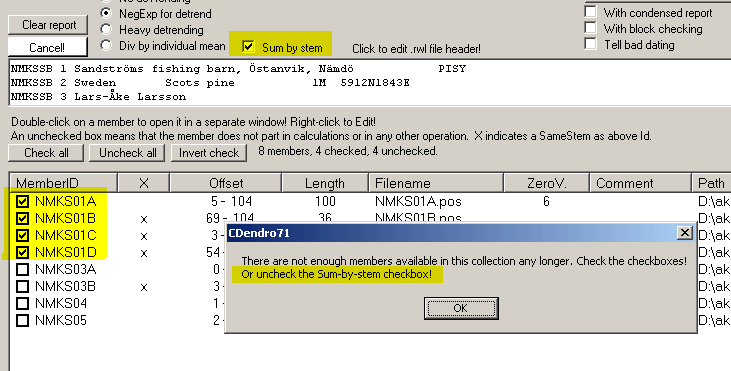
Note: When you have only radii from one stem checked in a collection then you HAVE TO uncheck the "Sum by stem" box to get your result.
Otherwise you'll get the error message shown above.
More on Multi-radii collections

|
The figure above shows a collection, SNDemo, consisting of ten series measured from only four different trees.
Each radius has been given a member identity according to the naming standard described above.
If you then click on the Time lines diagram button (top right) with "Sum by stem" unchecked (see the arrow marked "1") you will get a time lines diagram showing where all your radii are located on the time line. Please note that the series are here sorted by their names. If you now check "Sum by stem" and click the Time lines diagram button again, the time lines diagram will "collapse" and show only one line for each tree, see below! |
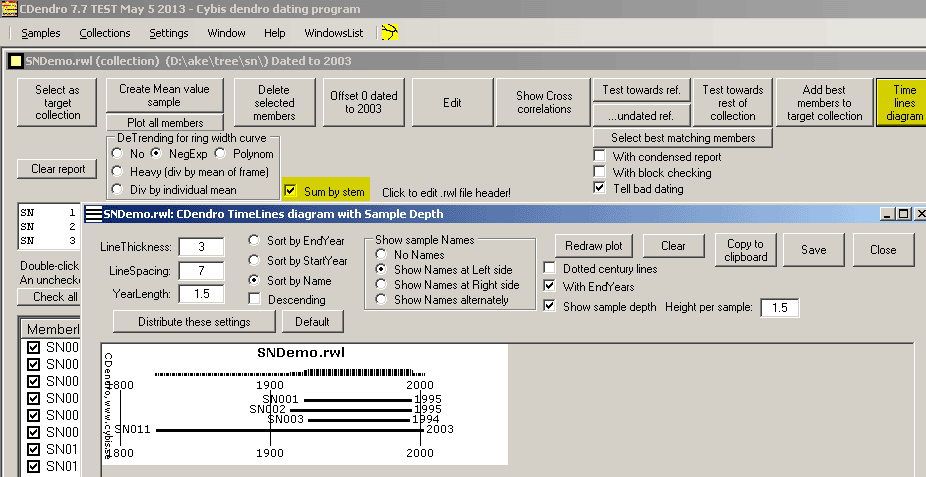
Collections/Save as New collection with members summed by stem
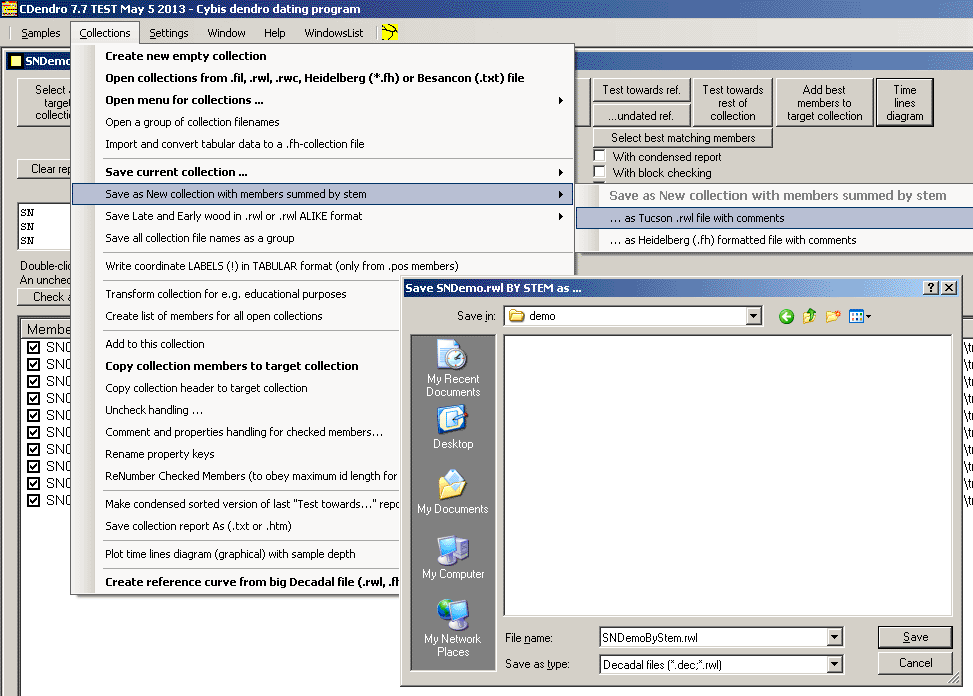
|
Since CDendro version 7.5 (May 2012) there is a separate menu command to "collapse" a multi-radii collection of
several trees into a collection where each tree is only represented by one member. Though this command "Collections/Save as New collection with members summed by stem"
requires that you follow a file naming convention (described above) which will tell CDendro which series (which .pos file) belong to which tree.
When CDendro calculates the series for a tree, it calculates each ring width as a plain mean value from all available radii from that tree. There is no detrending related to this process - it is only a process of calculating an average for each ring width of the tree. |

| The picture above shows the two collections, the SNDemo.rwl with all its radii series, SNDemoByStem.rwl with only one series for each tree. |
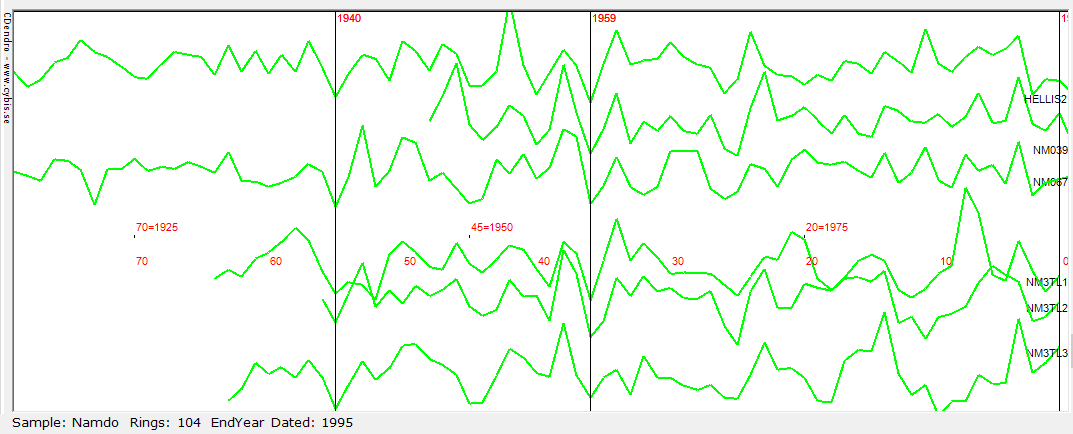 Multi curve diagrams:"Collection: Plot all members-button-diagram": Vertical rulers available by checkboxes and their tooltips. This ease to check synchronization between curves. Two rulers above show the years 1940 and 1959 - two very dry summers almost without rain. The plot-all-members button is found near the CDendro top-left corner of your collection to the right of and at the bottom of the Select-as-target-collection button. Note: Use the CDendro Settings/Plotting window settings frame to adjust the height of the plot window. Use the Curve separation and Curve height controls under the plot diagram (not shown above) for curve separation and height adjustments. Note: You can copy the image by clicking the "Copy curves to clipboard"-button and then paint that image into a document. Note: Vertical rulers: Vertical rulers are vertical lines crossing the curve diagram. They can be placed either at a certain year or anchored in the current reference curve. The corresponding year number is always printed at the top of the ruler. If you check "Settings/Plotting window settings/Print ring width for each ruler" you will get also the ring width printed below the year number. This might be useful for demonstrations or documentation. |